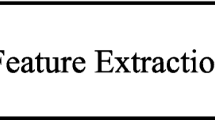Abstract
In this paper, we try to improve face recognition system by taking better advantage of the inherent 3D nature of the face. Face recognition can be greatly improved because the abundant 3D face features can be obtained from different angles. During the simulation, we try to extract the curvatures of the eyes, nose and mouth, which can be used as features for face recognition. The Gaussian curvature is an important component of our work. The distribution of this curvature is used to construct the feature vectors. In order to raise the recognition rate, the projection method is used to intensify the edge information. The mesh modification method is also applied to the 3D mesh models. Finally, the distance between the 3D normalized curvatures of the features is compared between the query and database images for recognition. Even when the facial expression of the query image has changed, we can still achieve a 92% recognition rate with our 3D face recognition algorithms.
Access this chapter
Tax calculation will be finalised at checkout
Purchases are for personal use only
Preview
Unable to display preview. Download preview PDF.
Similar content being viewed by others
References
Mahoor, M.H., Abdel-Mottaleb, M.: Face recognition based on 3D ridge images obtained from range data. Pattern Recognition 42, 445–451 (2009)
Xu, C., Li, S., Tan, T., Quan, L.: Automatic 3D face recognition from depth and intensity Gabor features. Pattern Recognition 42, 1895–1905 (2009)
Li, L., Liu, F., Li, C., Chen, G.: Realistic wrinkle generation for 3D face modeling based on automatically extracted curves and improved shape control functions. Computers & Graphics (2010) (in press, corrected proof)
LT 3D Face Camera, http://www.ltech.com.tw/
Jagannathan, A., Miller, E.L.: Three-Dimensional Surface Mesh Segmentation Using Curvedness-Based Region Growing Approach. IEEE Transactions Pattern Analysis and Machine Intelligence 29, 2195–2204 (2007)
Ceron, A., Salazar, A., Prieto, F.: Relevance analysis of 3D curvature-based shape descriptors on interest points of the face. In: 2010 2nd International Conference Image Processing Theory Tools and Applications (IPTA), Paris, Frence, July 7-10 (2010)
Li, X., Shephard, M.S., Beall, M.W.: 3D anisotropic mesh adaptation by mesh modification. Computer Methods in Applied Mechanics and Engineering 194, 4915–4950 (2005)
Besl, P.J., McKay, H.D.: A method for registration of 3-D shapes. IEEE Transactions on Pattern Analysis and Machine Intelligence 14, 239–256 (1992)
Rusinkiewicz, S., Levoy, M.: Efficient variants of the ICP algorithm. In: 2001 Proceedings of the Third International Conference on 3-D Digital Imaging and Modeling, pp. 145–152 (2001)
Jagannathan, A., Miller, E.L.: Three-Dimensional Surface Mesh Segmentation Using Curvedness-Based Region Growing Approach. IEEE Transactions Pattern Analysis and Machine Intelligence 29, 2195–2204 (2007)
Peng, J., Li, Q., Kuo, C.-C.J., Zhou, M.: Estimating Gaussian curvatures from 3D meshes. In: Human Vision and Electronic Imaging VIII, vol. 5007, pp. 270–280 (2003)
Verevka, O., Buchanan, J.W.: Local K-means Algorithm for Colour Image Quantization. M.Sc. Dissertation, Department of Computing Science. University of Alberta, Canada (1995)
Chen, J., Medioni, G.: Detection, Localization, and Estimation of Edges. IEEE Trans. PAMI PAMI-11(2), 191–198 (1989)
Zhong, C., Sun, Z., Tan, T.: Robust 3D face recognition using learned visual codebook. Pattern Recognition, 1–6 (2007)
Turk, M., Pentland, A.: Eigenfaces for recognition. Journal of Cognitive Neuroscience 3, 72–86 (1991)
Author information
Authors and Affiliations
Editor information
Editors and Affiliations
Rights and permissions
Copyright information
© 2013 Springer-Verlag Berlin Heidelberg
About this chapter
Cite this chapter
Lin, SW., Hao, SS., Chang, JL., Li, SY. (2013). 3D Face Recognition Based on Curvature Feature Matching, with Expression Variation. In: Lee, S., Cho, H., Yoon, KJ., Lee, J. (eds) Intelligent Autonomous Systems 12. Advances in Intelligent Systems and Computing, vol 193. Springer, Berlin, Heidelberg. https://doi.org/10.1007/978-3-642-33926-4_27
Download citation
DOI: https://doi.org/10.1007/978-3-642-33926-4_27
Publisher Name: Springer, Berlin, Heidelberg
Print ISBN: 978-3-642-33925-7
Online ISBN: 978-3-642-33926-4
eBook Packages: EngineeringEngineering (R0)




